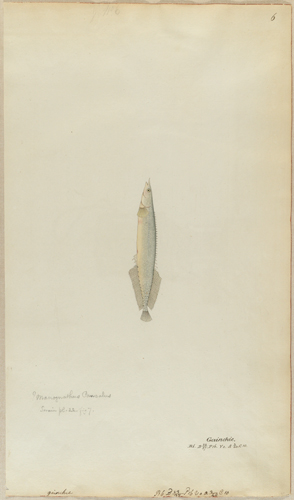Each time that a new work is scheduled to replace one coming off display in the galleries, curatorial staff have a chance to conduct extensive intellectual work: verifying and updating information about an object, and making sure its record reflects the most up-to-date scholarship.
A work recently installed in our South Asian galleries provided one such opportunity—and a uniquely edifying research experience that raised possibilities for future investigation. The object is one of two works on paper from the early 19th-century album Fishes of India. Acquired just before the museums’ renovation, it hadn’t yet been exhibited or comprehensively researched.
Shaded with watercolor and gouache, the drawing depicts a long, narrow fish, with alphanumeric notations below it and “Macrognathus Pancalus,” the species’ Linnaean name, written in pencil. The album to which the drawing originally belonged is thought to be a Company School work, completed for officers or other employees of the British East India Company, usually by Indian artists. Because these sorts of works were made before the time of widespread photography, naturalists and natural historians might have consulted them to study flora and fauna.
As Stephanie Rozman, the Calderwood Curatorial Fellow in Islamic and Later Indian Art, began to prepare the drawing for display, she became curious about the words and letters on the page. “I thought that they were probably communicating information in a standard notation of some kind that I didn’t recognize,” she said.
Taking advantage of Harvard’s vast network of scholars, Rozman asked for help from George V. Lauder, curator of the ichthyology department at the Museum of Comparative Zoology, as well as his colleagues Karsten Hartel and Andrew Williston. They determined that the letters and numbers were counts of the spines and rays in different fins that help to make distinctions between species, and they invited Rozman to visit their museum to examine a related fish specimen in person—an uncommon firsthand experience for an art historian.
As she looked over the preserved fish, Rozman was struck by an observation from Williston: “He pointed out that the counts of the spines and rays in the notes were slightly different than the number of spines and rays that actually appear in the drawing,” said Rozman. “At the very least, it suggests that the drawing is not an illustration of a fish that has those very features, and the notes are not necessarily describing the fish pictured.”
This dissonance between the notes and the drawing, as well as the drawing’s relatively small size in the middle of the larger page, raises questions about how the Fishes of India volume may have been used over time. Sumptuous books of plants and animals were collected in Britain during the late 18th and 19th centuries, but the drawings in this group are not as large and detailed as the images in other volumes prepared for officers of the East India Company. What’s more, the pencil inscription with the Linnaean name for the fish could not have been written until after 1822—when the species was identified. “This could mean that it was added later, or that the drawing itself was created later than we think,” Rozman said.
“The chronological relationship between these different elements—the drawing, the notations in ink, and the penciled text—is not clear yet, but the fact that they don’t neatly correspond suggests directions for further research,” Rozman said. Future investigations might examine the drawing in relation to other works of this type, and shine light on the artists, patrons, and collectors of books and specimens who studied or traveled to the Indian subcontinent during the 19th century.
Rozman will give an In-Focus Talk about this drawing and related works on display in the South Asian galleries on Tuesday, August 4.


